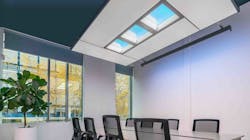Signify aims all-in-one artificial skylight, circadian luminaire, color system at office wellbeing
With commercial office wellbeing in mind, Signify has introduced a lighting system that simulates natural outdoor light via three LED-based parts — an artificial skylight; general illumination luminaires that shift spectral content in the sun’s daily rhythm; and a linear light source that projects colors on a wall.
The new NatureConnect system will get a trial run in Warsaw, where Swedish construction company Skanska is installing it at its own office. Skanska, a major commercial property developer, could eventually integrate the Signify product into projects for its customers.
“Office workers spend the majority of their time indoors,” said Katarzyna Zawodna-Bijoch, CEO of Skanska’s commercial development business in Central Eastern Europe. “The quality of the space influences their health, comfort, and efficiency. Research shows that quality lighting significantly impacts how we feel and how effective we are. The project which we conduct with Signify provides us a new opportunity to continuously improve people’s office experience.”
NatureConnect aims to facilitate a productive environment by delivering light that enhances employee mood and comfort, and that also fosters quality of sleep later at night. It embraces circadian lighting principles in which “Daylight” luminaires change their frequency during the course of an office day, generally starting with sunrise hues that give way to increasing levels of stimulating blues before shifting to warmer colors later in the day, imitating the daily pattern of the sun. The “Skylight” is intended to provide a sense of space and openness, while the “Lightscape” is intended to provide colors that boost positive emotions, creativity, and collaboration.
Signify is not the first to market with such a system. Both Cree Lighting and Italy’s CoeLux already provide artificial skylights and spectral shifting luminaires. Cree Lighting won LEDs Magazine’s 2020 Sapphire Award in the Lighting for Health and Wellbeing category, as well as earning its software developers the Illumineer of the Year honors for its Cadiant.
Signify’s NatureConnect adds color options with NatureConnect’s Lightscape, which provides light scenes projected onto a surface such as a wall.
Users such as Skanska can adjust the output of Lightscape and of the luminaires and the skylight. Signify declined to provide details of the control system to LEDs, other than to say it relies on a gateway that addresses each of the components — Skylight, Daylight, and Lightscape — “through a few communication protocols.” A spokesperson also noted that “each of the components is orchestrated such that they play in sync and create the appropriate light scene.”
The company also declined to provide pricing information.
A recent LEDs survey showed that lighting for health is a burgeoning application for the lighting industry. Many early implementations have been in the healthcare field, such as at the ACC Care Center in Sacramento, CA, and at Copenhagen University Hospital’s Righospitalet.
Activity is picking up in many ways including metrics, as Bridgelux has proposed a new way of measuring the natural light quality of artificial light. That proposal does not appear to have been on Signify’s radar.
“NatureConnect developed this innovation based on biophilic design principles and brings the benefits of natural light indoors,” the Signify spokesperson told LEDs. Biophilic design aims to make occupants of a building feel connected to nature, using both natural and artificial elements from lighting and other fields.
Signify began making NatureConnect available in Europe this week. It did not release a schedule for other geographic areas.
It comes just as the lighting industry must be pondering the general future of commercial office lighting in a world that has moved from office working to home working during the coronavirus pandemic. That transition could continue. The CEO of Barclays Bank noted in late April that “the notion of putting 7,000 people in a building may be a thing of the past.”
Asked about that, the Signify spokesperson told LEDs, “The need for lighting that supports people’s connection with the natural daily rhythm will remain, and as this is a rather new innovation with direct connection to people’s health and wellbeing, poses an interesting growth opportunity for Signify,” the spokesperson said.
In other words, lighting products emphasizing health could have a strong future, especially in the psyche of the current climate.
MARK HALPER is a contributing editor for LEDs Magazine, and an energy, technology, and business journalist ([email protected]).
For up-to-the-minute LED and SSL updates, why not follow us on Twitter? You’ll find curated content and commentary, as well as information on industry events, webcasts, and surveys on our LinkedIn Company Page and our Facebook page.

Mark Halper | Contributing Editor, LEDs Magazine, and Business/Energy/Technology Journalist
Mark Halper is a freelance business, technology, and science journalist who covers everything from media moguls to subatomic particles. Halper has written from locations around the world for TIME Magazine, Fortune, Forbes, the New York Times, the Financial Times, the Guardian, CBS, Wired, and many others. A US citizen living in Britain, he cut his journalism teeth cutting and pasting copy for an English-language daily newspaper in Mexico City. Halper has a BA in history from Cornell University.





![The DesignLights Consortium continues to make progress in shifting outdoor lighting products and implementation practices toward a more restrained and thoughtful strategy. [Image does not represent a DLC qualified fixture.] The DesignLights Consortium continues to make progress in shifting outdoor lighting products and implementation practices toward a more restrained and thoughtful strategy. [Image does not represent a DLC qualified fixture.]](https://img.ledsmagazine.com/files/base/ebm/leds/image/2024/08/66be810888ae93f656446f61-dreamstime_m_265700653.png?auto=format,compress&fit=&q=45&h=139&height=139&w=250&width=250)
